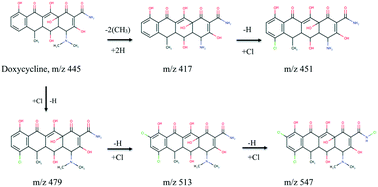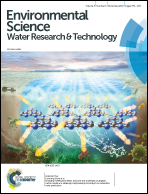Doxycycline transformation and emergence of antibacterially active products during water disinfection with chlorine†
Abstract
This study identified transformation products of doxycycline that formed during chlorine disinfection and evaluated the antibacterial properties of the products. Samples were analyzed by HPLC/MS/MS to identify the products. Antibacterial activity assays were used to determine the antibacterial properties of the products that formed during chlorine disinfection. Samples were run in both ultrapure water and final effluent collected from a local wastewater treatment facility. The ultrapure water experiments allowed the products to be easily detected, and the identified products were compared to those found in the wastewater matrix. Wastewater effluent was used as a realistic background matrix for a full-scale wastewater chlorination process. Products with antibiotic properties formed in ultrapure water. In the wastewater effluent, antibacterially active products did not form to a measurable extent. Five transformation products were seen in ultrapure and wastewater effluent samples. Both chlorinated and non-chlorinated transformation products were observed. While the same products were found in both matrices, their relative abundance was different; the non-chlorinated product forming preferentially in the wastewater matrix and chlorinated products forming in greater abundance in the ultrapure water matrix. This can be attributed to the competition for chlorine with the wastewater background, inhibiting the formation of active products. Furthermore, bromide was added at concentrations of 0.5–5 mg L−1 to both ultrapure water and wastewater matrices to assess the antibacterial activity of brominated products. The brominated products were observed, although none of them exhibited antibacterial activity. The results suggest that not only trace antibiotics but also their products could be the source of antibiotic resistance in the environment. The fate of other common antibiotics in water chlorination should be examined.



 Please wait while we load your content...
Please wait while we load your content...